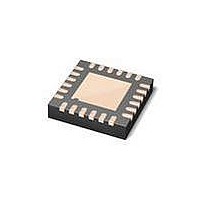MAX6581TG98+ Maxim Integrated Products, MAX6581TG98+ Datasheet - Page 14

MAX6581TG98+
Manufacturer Part Number
MAX6581TG98+
Description
Board Mount Temperature Sensors 1 C ACCUR 8-CH TEMP SENSR
Manufacturer
Maxim Integrated Products
Datasheet
1.MAX6581ATG9A.pdf
(24 pages)
Specifications of MAX6581TG98+
Full Temp Accuracy
+/- 1 C
Package / Case
TQFN-24
Digital Output - Bus Interface
I2C
Digital Output - Number Of Bits
11 bit
Supply Voltage (max)
3.6 V
Supply Voltage (min)
3 V
Description/function
Multichannel Temperature Sensor
Maximum Operating Temperature
+ 125 C
Minimum Operating Temperature
- 40 C
Supply Current
4 uA
Lead Free Status / RoHS Status
Lead free / RoHS Compliant
±1°C Accurate 8-Channel Temperature Sensor
If a channel’s input DXP_ and DXN_ are left open or are
shorted, the MAX6581 detects a diode fault. An open
diode fault does not cause either ALERT or OVERT to
assert. A bit in the status register for the correspond-
ing channel is set to 1 and the temperature data for the
channel is stored as all 1s (FFh). It takes approximately
4ms for the MAX6581 to detect a diode fault. Once a
diode fault is detected, the MAX6581 goes to the next
channel in the conversion sequence.
There are 17 alarm threshold registers that store over-
temperature and undertemperature ALERT and OVERT
threshold values. Nine of these registers are dedicated
to storing one local alert overtemperature threshold limit,
seven remote alert overtemperature threshold limits, and
one shared alert undertemperature temperature thresh-
old limit (see the ALERT Interrupt Mode section). The
remaining eight registers are dedicated to storing one
local overtemperature threshold limit and seven remote
channels to store overtemperature threshold limits (see
the OVERT Overtemperature Alarms section). Access to
these registers is provided through the SMBus interface.
ALERT interrupts occur when the internal or external
temperature reading exceeds a high-temperature limit
(user programmable) or a low-temperature limit. The
ALERT interrupt output signal can be cleared by reading
the status register(s) associated with the fault(s) or by
successfully responding to an alert response address
transmission by the master. In both cases, the alert is
cleared but is reasserted at the end of the next conver-
sion if the fault condition still exists. The interrupt does
not halt automatic conversions. The ALERT output is
open-drain so that multiple devices can share a common
interrupt line. All ALERT interrupts can be masked using
the ALERT Mask register (42h). The POR state of these
registers is shown in Table 3.
The SMBus alert response interrupt pointer provides
quick fault identification for simple slave devices that
lack the complex logic necessary to be a bus master.
Upon receiving an interrupt signal, the host master
can broadcast a receive-byte transmission to the alert
response slave address (19h). Then, any slave device
that generated an interrupt attempts to identify itself by
putting its own address on the bus.
The alert response can activate several different slave
devices simultaneously, similar to the I
14
_____________________________________________________________________________________
ALERT Responses Address
Alarm Threshold Registers
ALERT Interrupt Mode
Diode Fault Detection
2
C general call.
If more than one slave attempts to respond, bus arbitra-
tion rules apply, and the device with the lower address
code wins. The losing device does not generate an
acknowledgment and continues to hold the ALERT line
low until cleared (the conditions for clearing an alert
vary depending on the type of slave device.) Successful
completion of the alert response protocol clears the out-
put latch. If the condition that caused the alert still exists,
the MAX6581 reasserts the ALERT interrupt at the end of
the next conversion.
The MAX6581 has eight overtemperature registers that
store alarm threshold data for the OVERT output. OVERT
is asserted when a channel’s measured temperature
is greater than the value stored in the corresponding
threshold register. OVERT remains asserted until the
temperature drops below the programmed threshold
minus 4NC hysteresis. An overtemperature output can be
used to activate a cooling fan, send a warning, initiate
clock throttling, or trigger a system shutdown to prevent
component damage. See Table 3 for the POR state of the
overtemperature threshold registers.
The 8-bit Command Byte register (Table 3) is the master
index that points to the various other registers within the
MAX6581. This register’s POR state is 0000 0000 (00h).
The Configuration register (Table 4) has several
functions. Bit 7 (MSB) is used to put the MAX6581
either in software-standby mode (STOP) or continuous-
conversion mode. Bit 6 resets all registers to their POR
conditions and then clears itself. Bit 5 disables the
SMBus timeout. Bit 1 sets the extended range of the
remote temperature diodes. The remaining bits of the
Configuration register are not used. The POR state of this
register is 0000 0000 (00h).
The ALERT Mask register functions are described
in Table 5. Bits [7:0] are used to mask the ALERT
interrupt output. Bit 6 masks the local alert interrupt and
the remaining bits mask the remote alert interrupts. The
power-up state of this register is 0000 0000 (00h).
Table 6 describes the OVERT Mask register. Bit 6 and
the remaining bits mask the OVERT interrupt output for
all channels. The power-up state of this register is 0000
0000 (00h).
Command Byte Register Functions
OVERT Overtemperature Alarms
Configuration Register (41h)
OVERT Mask Register (43h)
ALERT Mask Register (42h)












